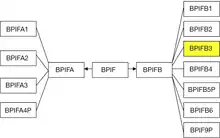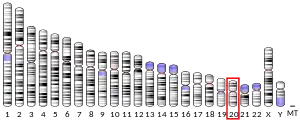| BPIFB3 | |||||||||||||||||||||||||||||||||||||||||||||||||||
|---|---|---|---|---|---|---|---|---|---|---|---|---|---|---|---|---|---|---|---|---|---|---|---|---|---|---|---|---|---|---|---|---|---|---|---|---|---|---|---|---|---|---|---|---|---|---|---|---|---|---|---|
| Identifiers | |||||||||||||||||||||||||||||||||||||||||||||||||||
| Aliases | BPIFB3, C20orf185, LPLUNC3, RYA3, dJ726C3.4, BPI fold containing family B member 3 | ||||||||||||||||||||||||||||||||||||||||||||||||||
| External IDs | OMIM: 615717 MGI: 2675077 HomoloGene: 18807 GeneCards: BPIFB3 | ||||||||||||||||||||||||||||||||||||||||||||||||||
| |||||||||||||||||||||||||||||||||||||||||||||||||||
| |||||||||||||||||||||||||||||||||||||||||||||||||||
| |||||||||||||||||||||||||||||||||||||||||||||||||||
| |||||||||||||||||||||||||||||||||||||||||||||||||||
| |||||||||||||||||||||||||||||||||||||||||||||||||||
| Wikidata | |||||||||||||||||||||||||||||||||||||||||||||||||||
| |||||||||||||||||||||||||||||||||||||||||||||||||||
BPI fold containing family B, member 3 (BPIFB3) is a protein that in humans is encoded by the BPIFB3 gene.[5] Two variants have been detected in humans.[6][7]
Superfamily
BPIFB3 is a member of a BPI fold protein superfamily defined by the presence of the bactericidal/permeability-increasing protein fold (BPI fold) which is formed by two similar domains in a "boomerang" shape.[8] This superfamily is also known as the BPI/LBP/PLUNC family or the BPI/LPB/CETP family.[9] The BPI fold creates apolar binding pockets that can interact with hydrophobic and amphipathic molecules, such as the acyl carbon chains of lipopolysaccharide found on Gram-negative bacteria, but members of this family may have many other functions.

Genes for the BPI/LBP/PLUNC superfamily are found in all vertebrate species, including distant homologs in non-vertebrate species such as insects, mollusks, and roundworms.[10][11] Within that broad grouping is the BPIF gene family whose members encode the BPI fold structural motif and are found clustered on a single chromosome, e.g., Chromosome 20 in humans, Chromosome 2 in mouse, Chromosome 3 in rat, Chromosome 17 in pig, Chromosome 13 in cow. The BPIF gene family is split into two groupings, BPIFA and BPIFB. In humans, BIPFA consists of 3 protein encoding genes BPIFA1, BPIFA2, BPIFA3, and 1 pseudogene BPIFA4P; while BPIFB consists of 5 protein encoding genes BPIFB1, BPIFB2, BPIFB3, BPIFB4, BPIFB6 and 2 pseudogenes BPIFB5P, BPIFB9P. What appears as pseudogenes in humans may appear as fully functional genes in other species.
BPIFB3 was first directly identified in a screen of rat olfactory epithelium as RYA3[12] and was recognized to be a member of the BPI fold superfamily.[13][11] In humans, it was formerly known as "Long palate, lung and nasal epithelium carcinoma-associated protein 3" encoded by the LPLUNC3 gene. The BPIFB3 gene is found with other members of the BPIF gene family in a cluster on chromosome 20.
Function
BPIFB3/RYA3 is highly expressed in olfactory epithelium and the tongue,[12][13] within the cytoplasm of cells, and is thought to be similar to an odorant binding protein which presents odorant molecules to chemical odorant receptor molecules.[14]
Like other BPI-fold family members involved in defense from infection, BPIFB3 may be involved in responses to viral infections such as the enteroviruses coxsackievirus B and poliovirus in epithelial and endothelial tissue.[15][16] Its cytoplasmic location appears to be localized to the endoplasmic reticulum (ER) and influences the replication of coxsackievirus B; when BPIFB3 is knocked out in experimental systems coxsackievirus B replication dramatically increases. It has been within observed in the ER to be physically associated with another family member, BPIFB6, and modulation of either of these two proteins can enhance or suppress enteroviral release from cells. [17]
References
- 1 2 3 GRCh38: Ensembl release 89: ENSG00000186190 - Ensembl, May 2017
- 1 2 3 GRCm38: Ensembl release 89: ENSMUSG00000068008 - Ensembl, May 2017
- ↑ "Human PubMed Reference:". National Center for Biotechnology Information, U.S. National Library of Medicine.
- ↑ "Mouse PubMed Reference:". National Center for Biotechnology Information, U.S. National Library of Medicine.
- ↑ "BPIFB3 BPI fold containing family B member 3 [Homo sapiens (human)] - Gene - NCBI". www.ncbi.nlm.nih.gov.
- ↑ "Homo sapiens BPI fold containing family B member 3 (BPIFB3), transcript variant 1, mRNA". 31 December 2022.
- ↑ "Homo sapiens BPI fold containing family B member 3 (BPIFB3), transcript variant 2, mRNA". 31 December 2022.
- ↑ Beamer LJ, Carroll SF, Eisenberg D (April 1998). "The BPI/LBP family of proteins: a structural analysis of conserved regions". Protein Science. 7 (4): 906–914. doi:10.1002/pro.5560070408. PMC 2143972. PMID 9568897.
- ↑ "CDD Conserved Protein Domain Family: BPI". www.ncbi.nlm.nih.gov.
- ↑ Beamer LJ, Fischer D, Eisenberg D (July 1998). "Detecting distant relatives of mammalian LPS-binding and lipid transport proteins". Protein Science. 7 (7): 1643–1646. doi:10.1002/pro.5560070721. PMC 2144061. PMID 9684900.
- 1 2 Bingle CD, Seal RL, Craven CJ (August 2011). "Systematic nomenclature for the PLUNC/PSP/BSP30/SMGB proteins as a subfamily of the BPI fold-containing superfamily". Biochemical Society Transactions. 39 (4): 977–983. doi:10.1042/BST0390977. PMC 3196848. PMID 21787333.
- 1 2 Dear, TN; Boehm, T; Keverne, EB; Rabbitts, TH (October 1991). "Novel genes for potential ligand-binding proteins in subregions of the olfactory mucosa". The EMBO Journal. 10 (10): 2813–9. doi:10.1002/j.1460-2075.1991.tb07830.x. PMC 452990. PMID 1915264.
- 1 2 Andrault, JB; Gaillard, I; Giorgi, D; Rouquier, S (August 2003). "Expansion of the BPI family by duplication on human chromosome 20: characterization of the RY gene cluster in 20q11.21 encoding olfactory transporters/antimicrobial-like peptides". Genomics. 82 (2): 172–84. doi:10.1016/s0888-7543(03)00102-2. PMID 12837268.
- ↑ Rihani, Karen; Ferveur, Jean-François; Briand, Loïc (30 March 2021). "The 40-Year Mystery of Insect Odorant-Binding Proteins". Biomolecules. 11 (4): 509. doi:10.3390/biom11040509. PMC 8067015. PMID 33808208.
- ↑ Coyne, CB; Bozym, R; Morosky, SA; Hanna, SL; Mukherjee, A; Tudor, M; Kim, KS; Cherry, S (20 January 2011). "Comparative RNAi screening reveals host factors involved in enterovirus infection of polarized endothelial monolayers". Cell Host & Microbe. 9 (1): 70–82. doi:10.1016/j.chom.2011.01.001. PMC 3048761. PMID 21238948.
- ↑ Delorme-Axford, E; Morosky, S; Bomberger, J; Stolz, DB; Jackson, WT; Coyne, CB (9 December 2014). "BPIFB3 regulates autophagy and coxsackievirus B replication through a noncanonical pathway independent of the core initiation machinery". mBio. 5 (6): e02147. doi:10.1128/mBio.02147-14. PMC 4324245. PMID 25491355.
- ↑ Morosky S, Lennemann NJ, Coyne CB (May 2016). "BPIFB6 Regulates Secretory Pathway Trafficking and Enterovirus Replication". Journal of Virology. 90 (10): 5098–5107. doi:10.1128/JVI.00170-16. PMC 4859712. PMID 26962226.
External links
- Human BPIFB3 genome location and BPIFB3 gene details page in the UCSC Genome Browser.



